Mafic Intrusions in the Cuona Area, Eastern Tethyan Himalaya: Early Kerguelen Mantle Plume Activity and East Gondwana Rifting
Abstract
1. Introduction
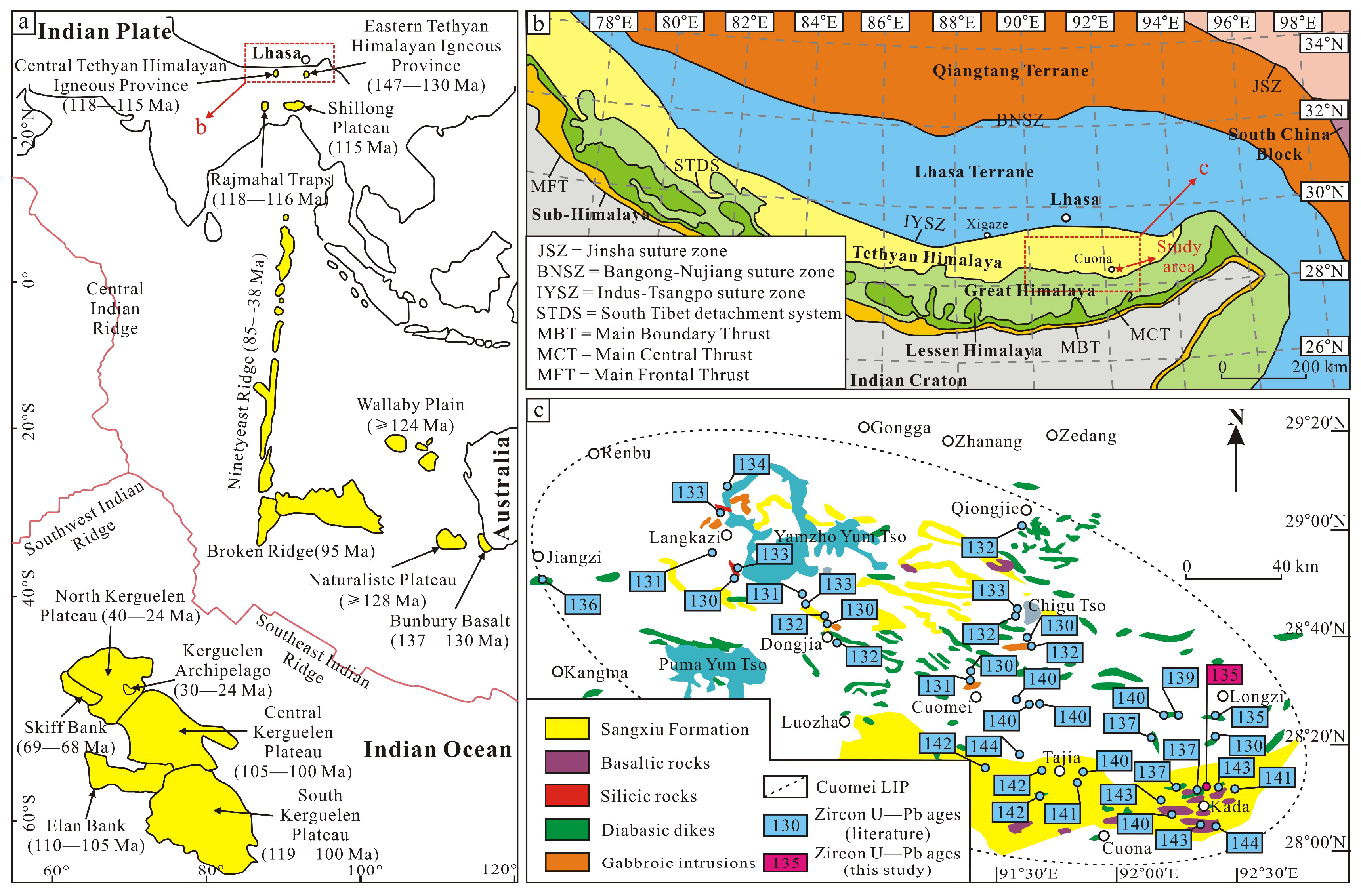
2. Geological Setting and Sample Descriptions
3. Methods
3.1. Zircon U–Pb Dating
3.2. Major and Trace Elements
3.3. Sr–Nd Isotopes
3.4. Zircon Hf Isotopes
4. Results
4.1. Zircon U–Pb Ages
4.2. Major and Trace Elements
4.3. Sr–Nd Isotopes
4.4. Zircon Hf Isotopes
5. Discussion
5.1. Ages
5.2. Fractional Crystallization and Crustal Contamination
5.3. Magma Sources and Tectonic Setting
5.4. Geological Significance
5.5. Kerguelen Mantle Plume and Evolution of Eastern Gondwana
6. Conclusions
- (1)
- The diabase porphyrite formed in the Early Cretaceous (135.0 ± 1.6 Ma). The diabase porphyrite and gabbro have a similar petrogenesis to the numerous OIB-type mafic igneous rocks in the Cuomei LIP, displaying typical OIB-type geochemical signatures without contamination by lithospheric mantle or crust. These rocks were likely derived from EMI-like enriched mantle. The diabase porphyrite formed in a continental rift setting related to the Kerguelen mantle plume, whereas the gabbro should be the product of the deep magma of the Kerguelen mantle plume in a stable continental intraplate environment.
- (2)
- The mafic intrusive rocks in the Cuona region are subalkaline to alkaline. There is significant fractionation between the light (enriched) and heavy (depleted) REEs and no significant Eu anomalies. The trace element characteristics of the diabase porphyrite and gabbro are similar, with both being enriched in HFSEs and LILEs. The diabase is enriched in large-ion lithophile elements (LILEs, e.g., La and Ce) and depleted in high-field-strength elements (HFSEs, e.g., Ru, Zr and Ti).
- (3)
- The age of the diabase porphyrite (135 Ma) is slightly older than the peak of Kerguelen mantle plume activity (132 Ma), indicating it was the product of East Gondwana continental rifting associated with the effects of the Kerguelen mantle plume.
Author Contributions
Funding
Data Availability Statement
Conflicts of Interest
References
- Zhu, D.; Pan, G.; Mo, X.; Liao, Z.; Jiang, X.; Wang, L.; Zhao, Z. Petrogenesis of volcanic rocks in the Sangxiu Formation, central segment of Tethyan Himalaya: A probable example of plume–lithosphere interaction. J. Asian Earth Sci. 2007, 29, 320–335. [Google Scholar] [CrossRef]
- Zhu, D.; Mo, X.; Pan, G.; Zhao, Z.; Dong, G.; Shi, Y.; Liao, Z.; Wang, L.; Zhou, C. Petrogenesis of the Earliest Early Cretaceous Mafic Rocks from the Cona Area of the Eastern Tethyan Himalaya in South Tibet: Interaction Between the Incubating Kerguelen Plume and the Eastern Greater India Lithosphere? Lithos 2008, 100, 147–173. [Google Scholar] [CrossRef]
- Chen, S.; Fan, W.; Shi, R.; Liu, X.; Zhou, X. 118–115 Ma Magmatism in the Tethyan Himalaya Igneous Province: Constraints on Early Cretaceous Rifting of the Northern Margin of Greater India. Earth Planet. Sci. Lett. 2018, 491, 21–33. [Google Scholar] [CrossRef]
- Chen, S.; Fan, W.; Shi, R.; Xu, J.; Liu, Y. The Tethyan Himalaya Igneous Province: Early Melting Products of the Kerguelen Mantle Plume. J. Petrol. 2021, 62, 301–320. [Google Scholar] [CrossRef]
- Shi, Y.; Hou, C.; Anderson, J.L.; Yang, T.; Bian, W.; Jin, J. Zircon SHRIMP U–Pb age of Late Jurassic OIB-type volcanic rocks from the Tethyan Himalaya: Constraints on the initial activity time of the Kerguelen mantle plume. Acta Geochim. 2018, 37, 441–455. [Google Scholar] [CrossRef]
- Tian, Y.; Gong, J.; Chen, H.; Guo, L.; Xu, Q.; Chen, L.; Lin, X.; Cheng, X.; Yang, R.; Zhao, L.; et al. Early Cretaceous bimodal magmatism in the eastern Tethyan Himalayas, Tibet: Indicative of records on precursory continental rifting and initial breakup of eastern Gondwana. Lithos 2018, 324, 699–715. [Google Scholar] [CrossRef]
- Zeng, Y.; Xu, J.; Chen, J.; Wang, B.; Huang, F.; Yu, H.; Chen, X.; Zhao, P. Breakup of Eastern Gondwana as Inferred from the Lower Cretaceous Charong Dolerites in the Central Tethyan Himalaya, Southern Tibet. Palaeogeogr. Palaeoclimatol. Palaeoecol. 2019, 515, 70–82. [Google Scholar] [CrossRef]
- Peng, W.; Yang, T.; Shi, Y.; Bian, W.; Ma, Y.; Wang, S.; Jiao, X.; Ma, J.; Kang, Y.; Zhang, S.; et al. Role of the Kerguelen Mantle Plume in Breakup of Eastern Gondwana: Evidence from Early Cretaceous Volcanic Rocks in the Eastern Tethyan Himalaya. Palaeogeogr. Palaeoclimatol. Palaeoecol. 2022, 588, 110823. [Google Scholar] [CrossRef]
- Liang, J.; Bian, W.; Jiao, X.; Peng, W.; Ma, J.; Wang, S.; Ma, Y.; Zhang, S.; Wu, H.; Li, H.; et al. Geochronological Results from the Zhela Formation Volcanics of the Tethyan Himalaya and Their Implications for the Breakup of Eastern Gondwana. Sci. Rep. 2023, 13, 20035. [Google Scholar] [CrossRef]
- Zhang, Z.; Li, G.; He, X.; Zhang, L.; Dong, S.; Liang, W.; Han, S. The evolution of Kerguelen mantle plume and breakup of eastern Gondwana: New insights from multistage Cretaceous magmatism in the Tethyan Himalaya. Gondwana Res. 2023, 119, 68–85. [Google Scholar] [CrossRef]
- Meng, F.; Meng, Y.; Wei, Y. Identification of the EMII-type Mantle End-member of the Kerguelen Mantle Plume and Its Implications for the Initial Breakup of Eastern Gondwana: New Constraints from the Cretaceous Diabase in the Tethyan Himalaya. J. Asian Earth Sci. 2024, 272, 106250. [Google Scholar] [CrossRef]
- Duncan, R.A.; Hooper, P.R.; Rehacek, J.; Marsh, J.S.; Duncan, A.R. The timing and duration of the Karoo igneous event, southern Gondwana. J. Geophys. Res. Solid Earth 1997, 102, 18127–18138. [Google Scholar] [CrossRef]
- Pirajno, F.; Santosh, M. Mantle plumes, supercontinents, intracontinental rifting and mineral systems. Precambrian Res. 2015, 259, 243–261. [Google Scholar] [CrossRef]
- Müller, R.D.; Royer, J.Y.; Lawver, L.A. Revised plate motions relative to the hotspots from combined Atlantic and Indian Ocean hotspot tracks. Geology 1993, 21, 275–278. [Google Scholar] [CrossRef]
- Bryan, S.E.; Constantine, A.E.; Stephens, C.J.; Ewart, A.; Schön, R.W.; Parianos, J. Early Cretaceous volcano-sedimentary successions along the eastern Australian continental margin: Implications for the break-up of eastern Gondwana. Earth Planet. Sci. Lett. 1997, 153, 85–102. [Google Scholar] [CrossRef]
- Zhu, D.; Chung, S.; Mo, X.; Zhao, Z.; Niu, Y.; Song, B.; Yang, Y. The 132 Ma Comei-Bunbury Large Igneous Province: Remnants Identified in Present-day Southeastern Tibet and Southwestern Australia. Geology 2009, 37, 583–586. [Google Scholar] [CrossRef]
- Wei, Y.; Liang, W.; Shang, Y.; Zhang, B.; Pan, W. Petrogenesis and Tectonic Implications of ~130 Ma Diabase Dikes in the Western Tethyan Himalaya (Western Tibet). J. Asian Earth Sci. 2017, 143, 236–248. [Google Scholar] [CrossRef]
- Wang, Z.; Shi, Y.; Yang, T.; Lawford Anderson, j.; Zhao, J.; Peng, X.; Hou, C.; Sun, H.; Bian, W.; Ma, Y. Early Activity of the Kerguelen Mantle Plume: Geochronology, Geochemistry and Sr-Nd-Pb Isotopes of Mafic Dykes and Sills from the Tethyan Himalaya. Int. Geol. Rev. 2022, 65, 512–526. [Google Scholar] [CrossRef]
- Jiang, S.; Nie, F.; Hu, P.; Liu, Y.; Lai, X. Geochemical Characteristics of Mafic Dykes in Southern Tibet. Acta Geol. Sin. 2007, 81, 60–71. (In Chinese) [Google Scholar]
- Tong, J.; Liu, J.; Zhong, H.; Xia, J.; Lu, R.; Li, Y. Zircon U-Pb Dating, Geochemistry, and Tectonic Significance of Mafic Dykes in the Luozha Area of Southern Tibet. Geol. Bull. China 2007, 26, 1654–1664. (In Chinese) [Google Scholar]
- Qiu, B.; Zhu, D.; Zhao, Z.; Wang, L. Western Extension and Significance of the Cuomei Large Igneous Province in Southern Tibet. Acta Petrol. Sin. 2010, 26, 2207–2216. (In Chinese) [Google Scholar]
- Xia, Y.; Zhu, D.; Zhao, Z.; Wang, Q.; Yuan, S.; Chen, Y.; Mo, X. Whole-Rock Geochemistry and Zircon Hf Isotopes of OIB-Type Mafic Rocks in the Cuomei Large Igneous Province, Southeastern Tibet. Acta Petrol. Sin. 2012, 28, 1588–1602. (In Chinese) [Google Scholar]
- Zhu, D.; Xia, Y.; Qiu, B.; Wang, Q.; Zhao, Z. Why Propose the Early Cretaceous Cuomei Large Igneous Province in Southeastern Tibet? Acta Petrol. Sin. 2013, 29, 3659–3670. (In Chinese) [Google Scholar]
- Ding, F.; Gao, J.; Xu, K. Geochemical and Geochronological Characteristics of Mafic Intrusions in the Rongbu Area of Southern Tibet and Their Geological Significance. Acta Petrol. Sin. 2020, 36, 391–408. (In Chinese) [Google Scholar]
- Zhou, Q.; Liu, Z.; Lai, Y.; Wang, G.; Liao, Z. Petrogenesis of Mafic and Felsic Rocks from the Comei Large Igneous Province, South Tibet: Implications for the Initial Activity of the Kerguelen Plume. Geol. Soc. Am. Bull. 2018, 130, 811–824. [Google Scholar] [CrossRef]
- Olierook, H.K.; Jiang, Q.; Jourdan, F.; Chiaradia, M. Greater Kerguelen Large Igneous Province Reveals No Role for Kerguelen Mantle Plume in the Continental Breakup of Eastern Gondwana. Earth Planet. Sci. Lett. 2019, 511, 244–255. [Google Scholar] [CrossRef]
- Tian, Y. Early Cretaceous Bimodal Magmatic Activity in the Eastern Tethyan Himalayas: A Marker for Continental Rifting and the Initial Breakup of East Gondwana. Lithos 2019, 324–325, 699–715. (In Chinese) [Google Scholar] [CrossRef]
- Lian, D.; Yang, J.; Liu, F.; Wu, Q.; Xu, Z. Fingerprints of the Kerguelen Mantle Plume in Southern Tibet: Evidence from Early Cretaceous Magmatism in the Tethyan Himalaya. J. Geol. 2021, 129, 207–231. [Google Scholar] [CrossRef]
- Yang, C.; Li, Y.; Zhang, J.; Zhang, G. Age, Genesis, and Tectonic Significance of the Karlong Gabbro in the Langkazi Area of Southern Tibet. Geol. Sci. 2022, 57, 399–414. (In Chinese) [Google Scholar]
- Liu, Z.; Zhou, Q.; Lai, Y.; Qing, C.; Li, X.; Wu, J.; Xia, X. Petrogenesis of the Early Cretaceous Laguila Bimodal Intrusive Rocks from the Tethyan Himalaya: Implications for the Break-up of Eastern Gondwana. Lithos 2015, 236–237, 190–202. [Google Scholar] [CrossRef]
- Coffin, M.F.; Pringle, M.S.; Duncan, R.A.; Gladczenko, T.P.; Storey, M.; Müller, R.D. Kerguelen Hotspot Magma Output since 130 Ma. J. Petrol. 2002, 43, 1121–1139. [Google Scholar] [CrossRef]
- Ingle, S.; Weis, D.; Doucet, S.; Mattielli, N. Hf isotope constraints on mantle sources and shallow-level contaminants during Kerguelen hot spot activity since ~120 Ma. Geochem. Geophys. Geosystems 2003, 4, 767–782. [Google Scholar] [CrossRef]
- Liu, Z.; Kang, Z.; Yang, F.; Qiao, Z.; Ma, C.; Shen, Y. Geochronology, Geochemistry, and Petrogenesis of Volcanic Rocks from the Eastern Tethyan Himalayas. Geol. Explor. J. 2024, 39, 219–231. (In Chinese) [Google Scholar]
- Olierook, H.K.; Jourdan, F.; Merle, R.E.; Timms, N.E.; Kusznir, N.; Muhling, J.R. Bunbury Basalt: Gondwana breakup products or earliest vestiges of the Kerguelen mantle plume? Earth Planet. Sci. Lett. 2016, 440, 20–32. [Google Scholar] [CrossRef]
- Yin, A.; Harrison, T.M. Geologic Evolution of the Himalayan-Tibetan Orogen. Annu. Rev. Earth Planet. Sci. 2000, 28, 211–280. [Google Scholar] [CrossRef]
- Hou, C. Zircon Geochronology, Geochemistry, and Geological Significance of the Lacon Formation Volcanic Rocks in the Tethyan Himalayas. Master’s Thesis., China University of Geosciences, Beijing, China, 2017. (In Chinese). [Google Scholar]
- Boger, S.D. Antarctic Geology: Extending a Gondwanan Perspective. Gondwana Res. 2011, 19, 548–566. [Google Scholar]
- Merdith, A.S.; Collins, A.S.; Williams, S.E.; Pisarevsky, S.; Foden, J.D.; Archibald, D.B.; Blades, M.L.; Alessio, B.L.; Armistead, S.; Plavsa, D.; et al. A Full-Plate Global Reconstruction of the Neoproterozoic. Gondwana Res. 2017, 50, 84–134. [Google Scholar] [CrossRef]
- Huang, Y.; Liang, W.; Zhang, L.; Li, G.; Huang, C.; Xia, X.; Dong, S.; Wu, J. Initial Rifting of the Tethyan Himalayas-Indo-Asian Crust: Evidence from Late Cretaceous OIB-Type Basalts in Southern Tibet. Earth Sci. 2018, 43, 2651–2663. (In Chinese) [Google Scholar]
- Pan, G.; Wang, L.; Yin, F.; Geng, Q.; Li, G.; Zhu, D. Review, Progress, and Prospects of the Formation and Evolution of the Tibetan Plateau. Sediment. Tethys Geol. 2022, 42, 151–175. (In Chinese) [Google Scholar]
- Liu, Y.; Gao, S.; Hu, Z.; Gao, C.; Zong, K.; Wang, D. Continental and Oceanic Crust Recycling-induced Melt-Peridotite Interactions in the Trans-North China Orogen: U-Pb Dating, Hf Isotopes and Trace Elements in Zircons from Mantle Xenoliths. J. Petrol. 2009, 51, 392–399. [Google Scholar] [CrossRef]
- Andersen, T. Correction of common lead in U-Pb analyses that do not report 204Pb. Chem. Geol. 2002, 192, 59–79. [Google Scholar] [CrossRef]
- Ludwig, K. A Plotting and Regression Program for Radiogenic Isotope Data; Open-File Report; 91-445; U.S. Geological Survey: Sunrise Valley Drive Reston, VA, USA, 1991. [Google Scholar]
- Wang, X.; Zhou, J.; Qiu, J.; Zhang, W.; LIU, X.; Zhang, G. LA-ICP-MS U-Pb zircon geochronology of the Neoproterozoic igneous rocks from northern Guangxi, south China: Implications for tectonic evolution. Precambrian Res. 2006, 145, 111–130. [Google Scholar] [CrossRef]
- Yuan, H.; Gao, S.; Liu, X.; Li, H.; Günther, D.; Wu, F. Accurate U-Pb Age and Trace Element Determinations of Zircon by Laser Ablation-Inductively Coupled Plasma-Mass Spectrometry. Geostand. Geoanal. Res. 2004, 28, 353–370. [Google Scholar] [CrossRef]
- Li, X.Y.; Wang, H.Y.; Fan, G.Q. Accurate determination of more than 40 trace elements in rock samples by ICP-MS. Priv. Sci. Technol. 2016, 18. (In Chinese) [Google Scholar]
- Liang, X.; Wei, G.; Li, X.; Liu, Y. Precise Determination of 143Nd/144Nd and Sm/Nd Ratios Using MC-ICPMS. Geochimica 2003, 32, 91–96. (In Chinese) [Google Scholar]
- Griffin, W.L.; Pearson, N.J.; Belousova, E.; Jackson, S.E.; Achterbergh, V.E.; O’Reilly, S.Y.; Shee, S.R. The Hf isotope composition of cratonic mantle: LAM-MC-ICP-MS analysis of zircon megacrysts in kimberlites. Geochim. Cosmochim. Acta 2000, 64, 133–147. [Google Scholar] [CrossRef]
- Pearce, J. A User’s Guide to Basalt Discrimination Diagrams. In Trace Element Geochemistry of Volcanic Rocks: Applications for Massive Sulphide Exploration; Geological Association of Canada Short Course Notes; Geological Association of Canada: Toronto, ON, Canada, 1996; Volume 12, pp. 79–113. [Google Scholar]
- Maniar, P.D.; Piccoli, P.M. Tectonic Discrimination of Granitoids. Geol. Soc. Am. Bull. 1989, 101, 635–643. [Google Scholar] [CrossRef]
- Wright, J.B. A Simple Alkalinity Ratio and Its Application to Questions of Non-Orogenic Granite Genesis. Geol. Mag. 1969, 106, 370–384. [Google Scholar] [CrossRef]
- Winchester, J.A.; Floyd, P.A. Geochemical discrimination of different magma series and their differentiation products using immobile elements. Chem. Geol. 1977, 20, 325–343. [Google Scholar] [CrossRef]
- Sun, S.S.; McDonough, W.F. Chemical and isotopic systematics of oceanic basalts: Implications for mantle composition and processes. Geol. Soc. Lond. Spec. Publ. 1989, 42, 313–345. [Google Scholar] [CrossRef]
- Deng, J. Paleomagnetic and Zircon U-Pb Geochronology of the Zhela Formation Volcanic Rocks in the Tethyan Himalayas. Master’s Thesis, China University of Geosciences, Beijing, China, 2021. (In Chinese). [Google Scholar]
- Ludden, J.N.; Thompson, G. Behaviour of Rare Earth Elements During Submarine Weathering of Tholeiitic Basalt. Nature 1978, 274, 147–149. [Google Scholar] [CrossRef]
- Bienvenu, P.; Bougault, H.; Joron, J.L.; Treuil, M.; Dmitriev, L. MORB Alteration: Rare-Earth Element/Non-Rare-Earth Hygromagmaphile Element Fractionation. Chem. Geol. 1990, 82, 1–14. [Google Scholar] [CrossRef]
- Staudigel, H.; Plank, T.; White, B.; Schmincke, H. Geochemical Fluxes During Seafloor Alteration of the Basaltic Upper Oceanic Crust: DSDP Sites 417 and 418. In Subduction: Top to Bottom; Geophysical Monograph Series; Advancing Earth and Space Sciences: Washington, DC, USA, 2013; Volume 96, pp. 19–38. [Google Scholar]
- Wilson, M.; Hyman, U. Igneous Petrogenesis; Springer: Dordrecht, The Netherlands, 1997. [Google Scholar]
- Lassiter, J.C.; Depaolo, D.J. Plume/Lithosphere Interaction in the Generation of Continental and Oceanic Flood Basalts: Chemical and Isotopic Constraints; American Geophysical Union (AGU): Washington, DC, USA, 2013. [Google Scholar]
- Weaver, B.L. The origin of ocean island basalt end-member compositions: Trace element and isotopic constraints. Earth Planet. Sci. Lett. 1991, 104, 381–397. [Google Scholar] [CrossRef]
- Rudnick, R.L.; Gao, S. Composition of the Continental Crust. Treatise Geochem. 2003, 3, 1–64. [Google Scholar]
- Taylor, S.R.; Mclennan, S.M. The continental crust: Its composition and evolution. J. Geol. 1985, 94, 57–72. [Google Scholar] [CrossRef]
- McDonough, W.F. Contraints on the composition of the continental lithospheric mantle. Earth Planet. Sci. Lett. 1990, 101, 1–18. [Google Scholar] [CrossRef]
- Shuguang, L. Ba-Nb-Th-La diagrams used to identify tectonic environments of ophiolite. Acta Petrol. Sin. 1993, 9, 146. [Google Scholar]
- Meschede, M. A method of discriminating between different type of mid-ocean ridge basalts and continental tholeiites with the Nb-Zr-Y diagram. Chem. Geol. 1998, 56, 207–218. [Google Scholar] [CrossRef]
- Pearce, J.A.; Norry, M.J. Petrogenetic Implications of Ti, Zr, Y, and Nb Variations in Volcanic Rocks. Contrib. Miner. Petrol. 1979, 69, 33–47. [Google Scholar] [CrossRef]
- Pearce, J. Trace element characteristics of lavas from destructive plate boundaries. In Andesites: Orogenic Andesites and Related Rocks; John and Wiley and Sons: Hoboken, NJ, USA, 1982. [Google Scholar]
- Wang, Y.; Zhang, C.; Xiu, S. Th/Hf-Ta/Hf Discrimination Diagram for Tectonic Environments of Basalt Formation. Acta Petrol. Sin. 2001, 17, 413–421. (In Chinese) [Google Scholar]
- Dong, L.; Li, G.; Zhang, Z.; Huang, Y.; Cao, H. Zircon U-Pb Ages, Geochemistry, and Sr-Nd-Pb Isotopes of Diabase Dykes from the Xuesha Area, Southern Tibet. J. Chengdu Univ. Technol. (Sci. Technol. Ed.) 2019, 46, 734–745. (In Chinese) [Google Scholar]
- Yang, G.; Li, Y.; Xiao, W.; Tong, L. OIB-type rocks within West Junggar ophiolitic melanges: Evidence for the accretion of seamounts. Earth-Sci. Rev. 2015, 150, 477–496. [Google Scholar] [CrossRef]
- Liu, H.; Wang, Y.; Cawood, P.A.; Guo, X. Episodic slab rollback and back-arc extension in the Yunnan-Burma region: Insights from Cretaceous Nb-enriched and oceanic-island basalt-like mafic rocks. Geol. Soc. Am. Bull. 2017, 129, B31604. [Google Scholar] [CrossRef]
- Ren, C. Geological Geochronology, Geochemistry, and Geological Significance of Early Cretaceous Magmatic Rocks in Cuomei, Tibet. Bachelor’s Thesis, China University of Geosciences, Beijing, China, 2015. (In Chinese). [Google Scholar]
- Zhu, D.; Pan, G.; Mo, X.; Liao, Z.; Jiang, X.; Wang, L.; Zhao, Z. Geochemistry and Petrogenesis of the Basalts from the Sanxiu Formation in the Central Tethyan Himalayas. Geochimica 2005, 7–19. (In Chinese) [Google Scholar]
- Ma, Y.; Yang, T.; Bian, W.; Zhang, S.; Wu, H.; Li, H. Early Cretaceous paleomagnetic and geochronologic results from the Tethyan Himalaya: Insights into the Neotethyan paleogeography and the India-Asia collision. Sci. Rep. 2016, 6, 21605. [Google Scholar] [CrossRef]
- Davis, J.K.; Lawver, L.A.; Norton, I.O.; Gahagan, L.M. New Somali Basin magnetic anomalies and a plate model for the early Indian Ocean. Gondwana Res. 2016, 34, 16–28. [Google Scholar] [CrossRef]
- Storey, B.C. The role of mantle plumes in continental breakup: Case histories from Gondwanaland. Nature 1995, 377, 301–308. [Google Scholar] [CrossRef]
- Gibbons, A.D. The breakup of East Gondwana: Assimilating constraints from Cretaceous ocean basins around India into a best-fit tectonic model. J. Geophys. Res. Solid Earth 2013, 118, 808–822. [Google Scholar] [CrossRef]
- Jiang, Q.; Jourdan, F.; Olierook, H.K. Longest continuously erupting large igneous province driven by plume-ridge interaction. Geology 2020, 49, 206–210. [Google Scholar] [CrossRef]
- Torsvik, T.H.; Van der Voo, R.; Preeden, U.; Niocaill, C.M.; Steinberger, B.; Doubrovine, P.V.; Hinsbergen, D.; Domeier, M.; Gaina, C.; Tohver, E. Phanerozoic polar wander, palaeogeography and dynamics. Earth-Sci. Rev. 2012, 114, 325–368. [Google Scholar] [CrossRef]
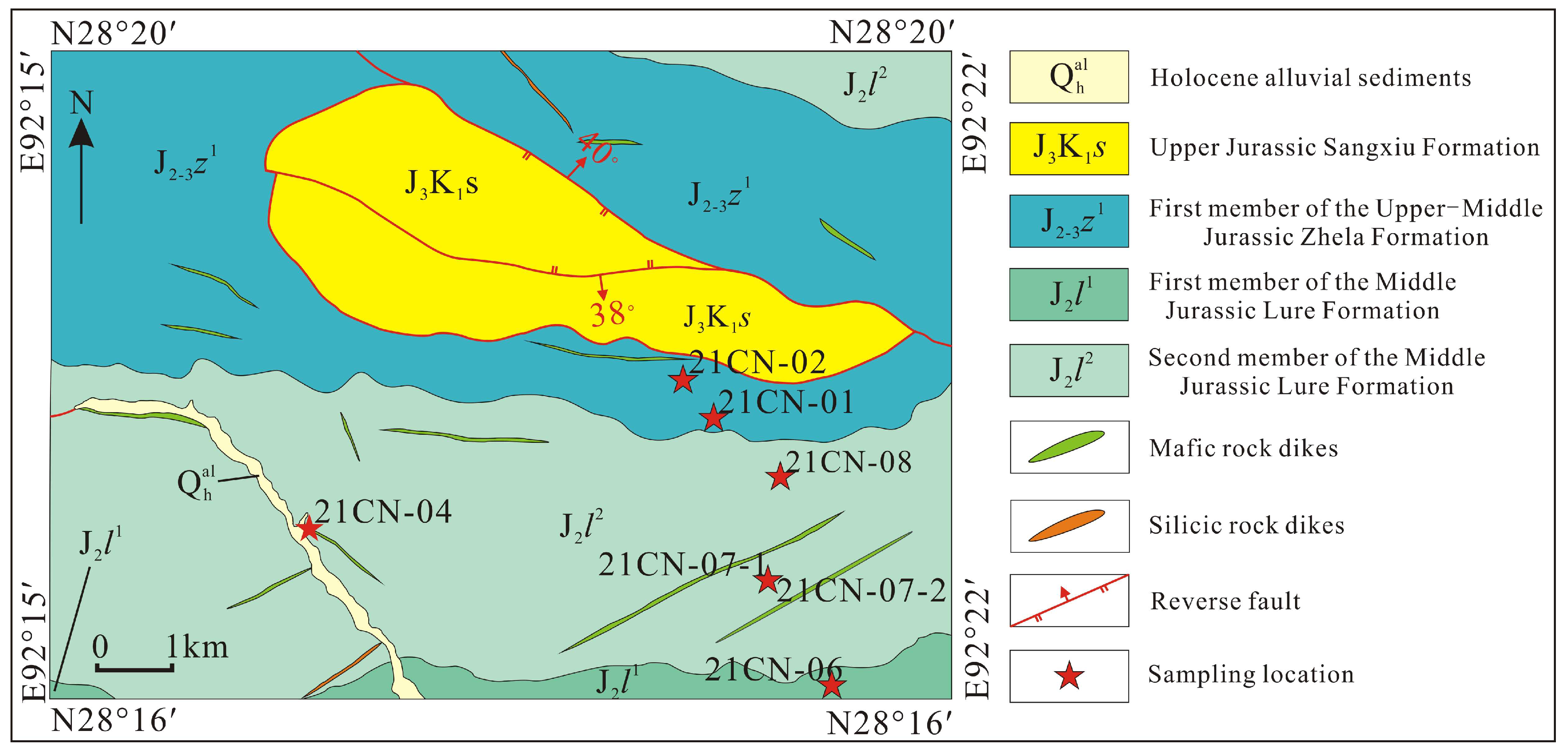



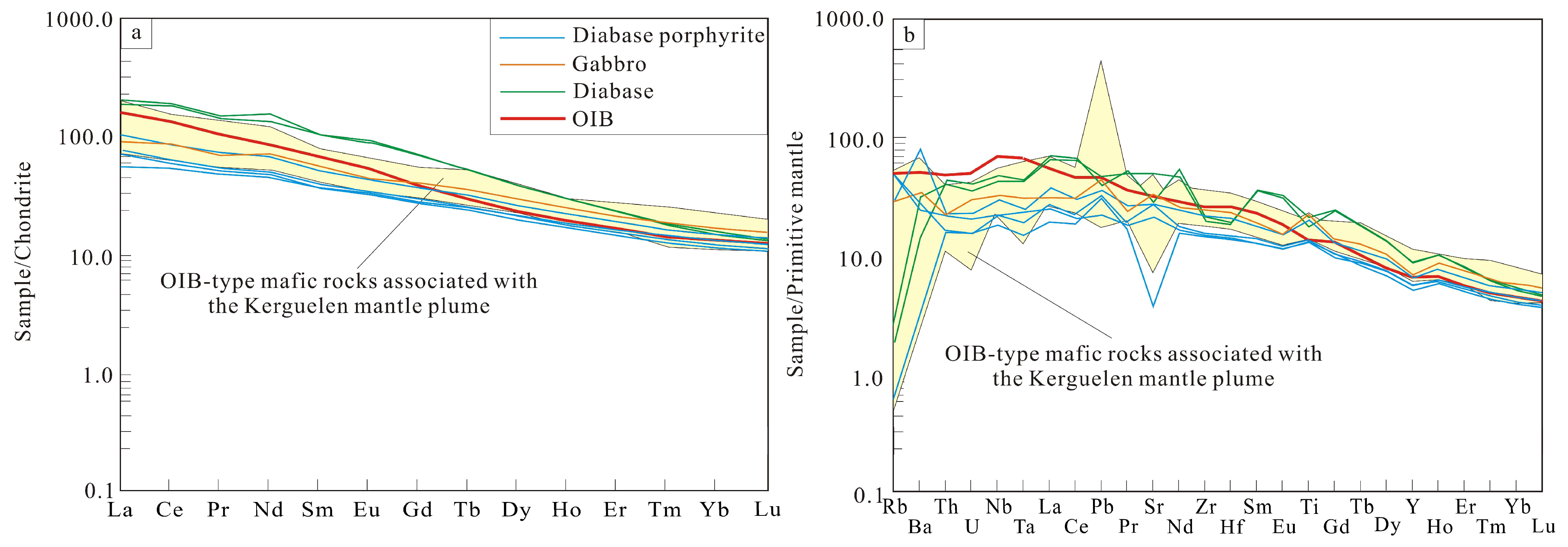
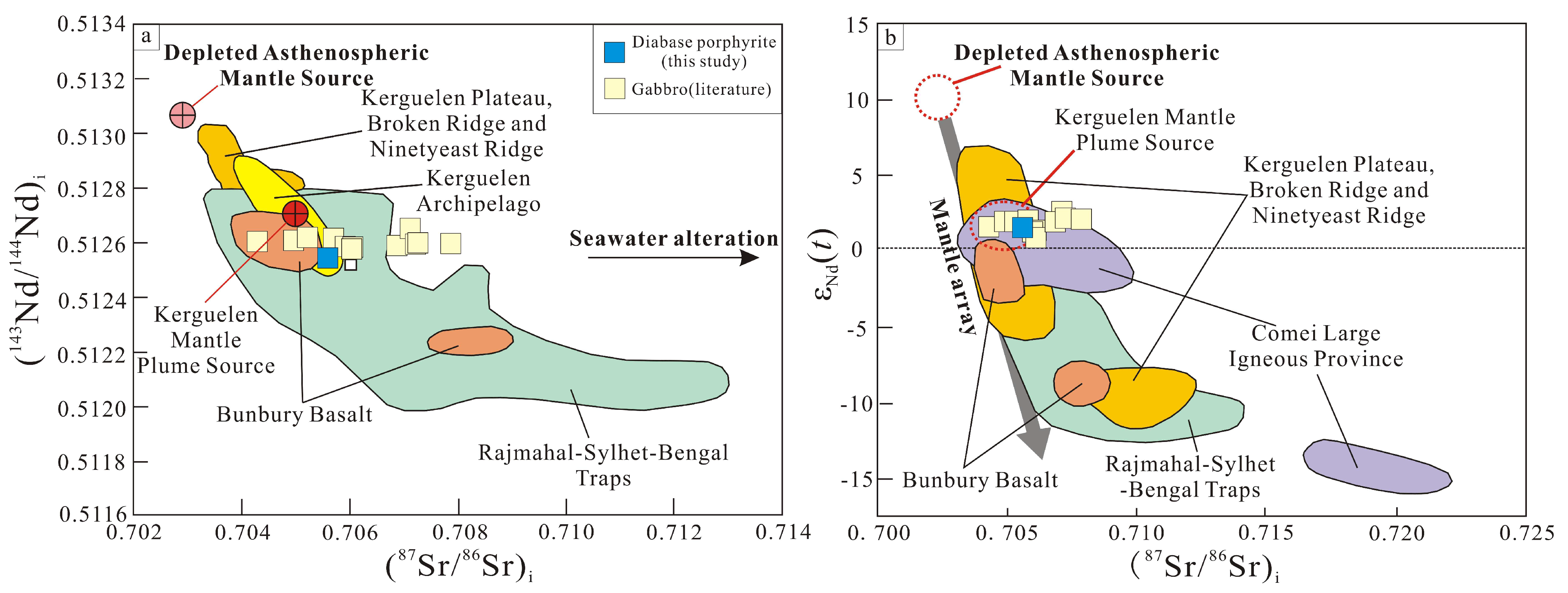
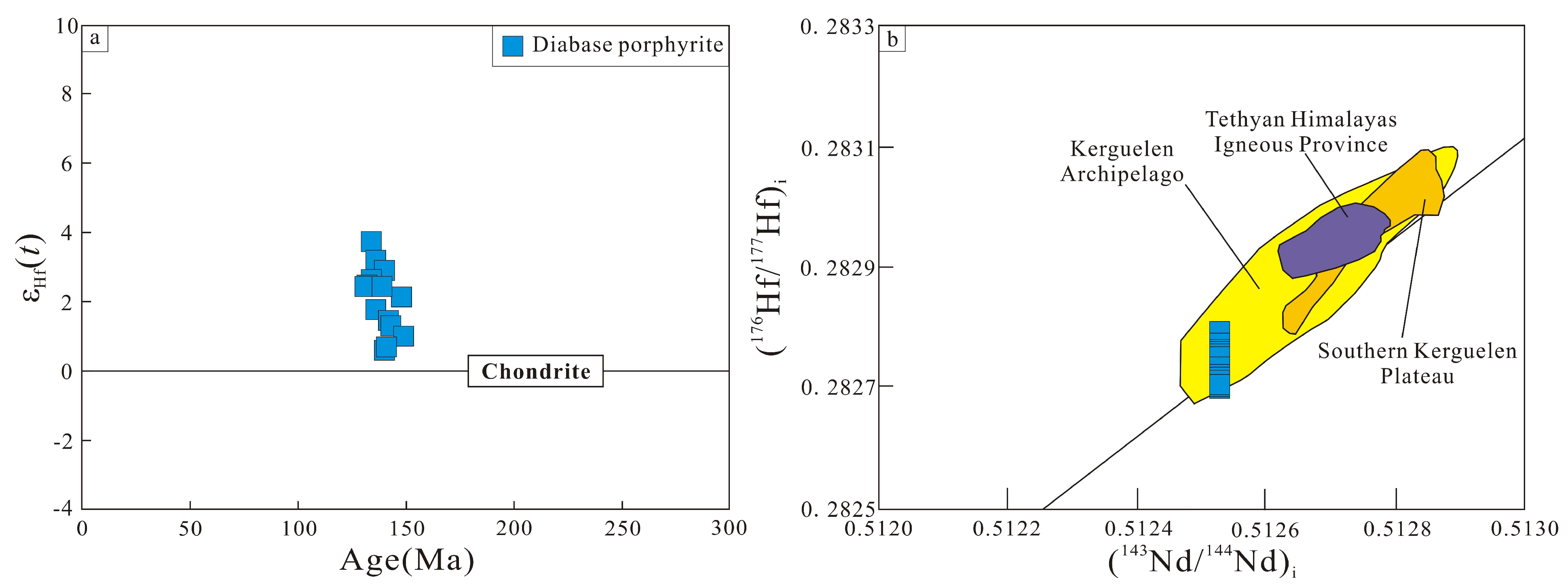


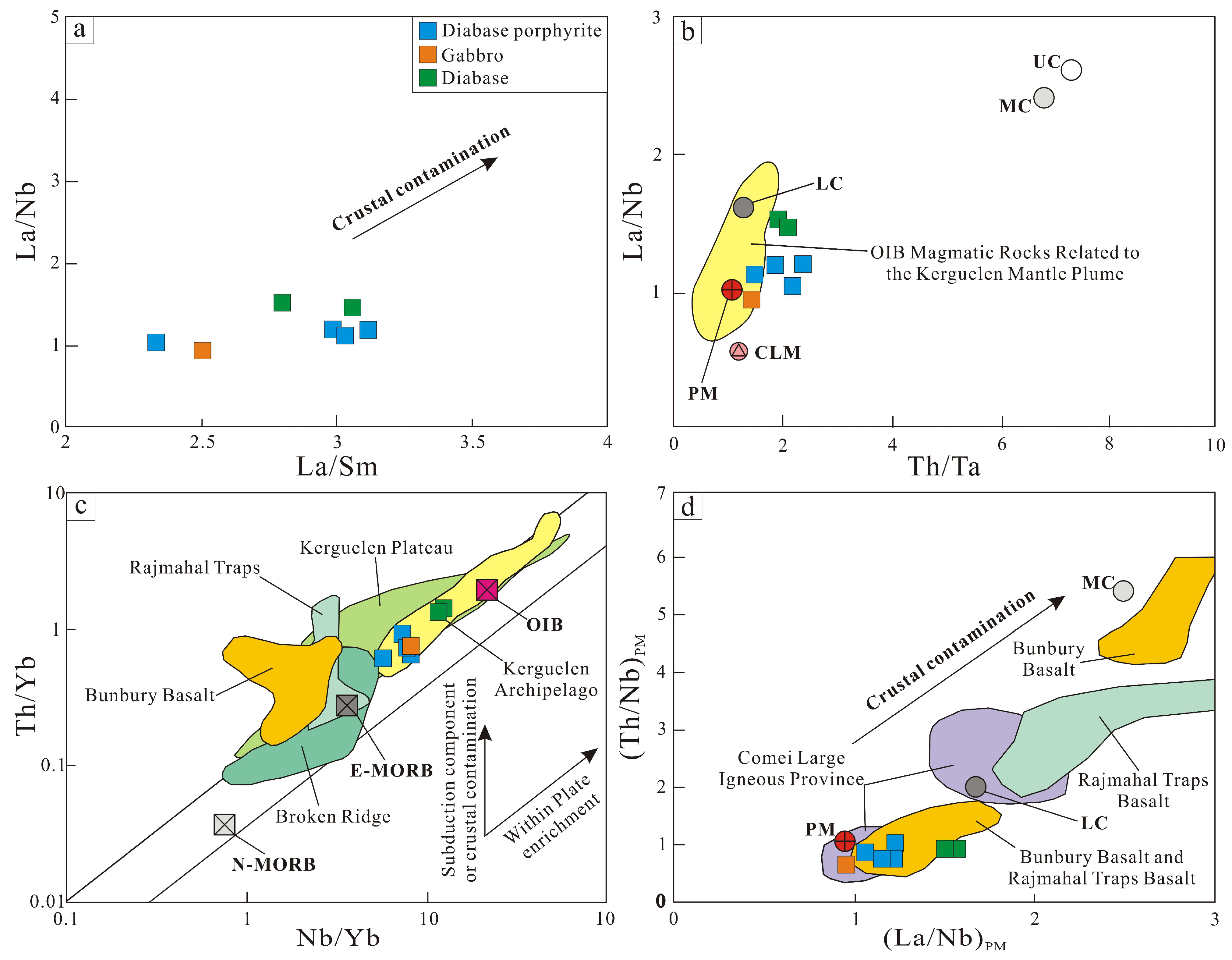

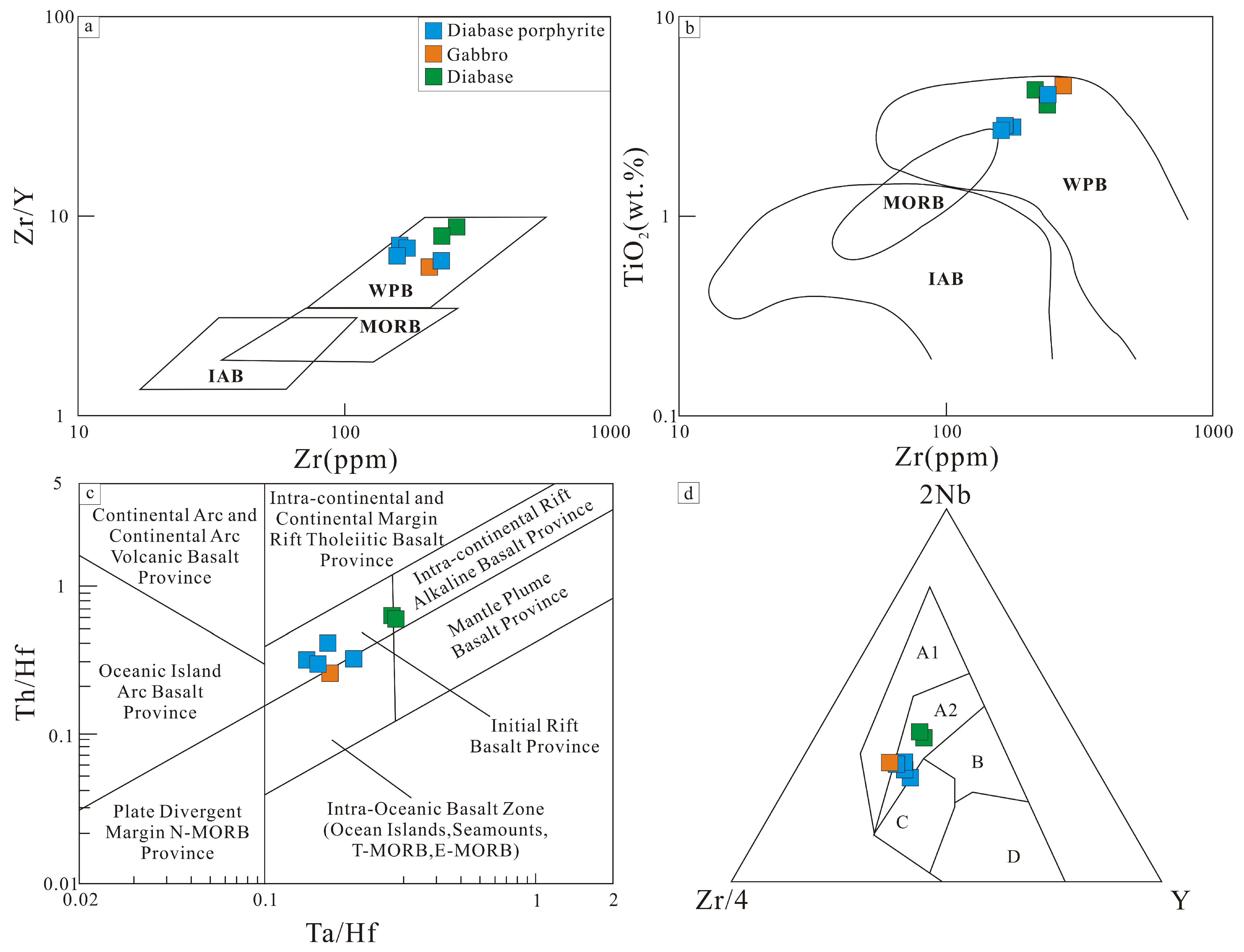
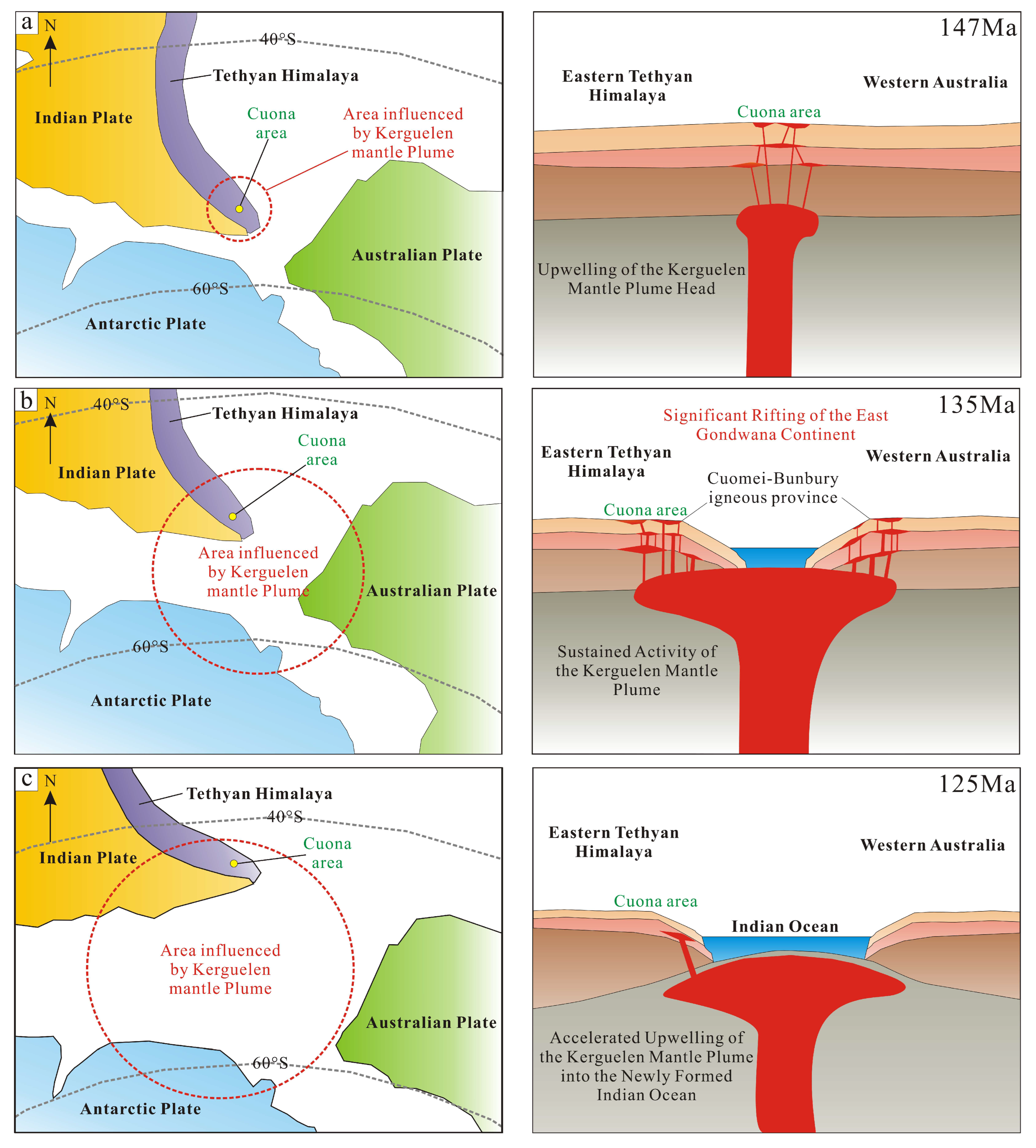
| Sample Point | Content/10−6 | Th/U | Isotopic Ratio | Isotopic Age/Ma | |||||||||
|---|---|---|---|---|---|---|---|---|---|---|---|---|---|
| Pb | Th | U | 207Pb/235U | 1σ | 206Pb/238U | 1σ | 207Pb/235U | 1σ | 206Pb/238U | 1σ | Con* | ||
| 21CN-02-06 | 21.77792 | 755.0443 | 739.7702 | 1.02 | 0.14585 | 0.00607 | 0.02159 | 0.00023 | 138.2 | 5.4 | 137.7 | 1.4 | 99% |
| 21CN-02-11 | 32.31679 | 1302.509 | 1049.637 | 1.24 | 0.14207 | 0.00551 | 0.02125 | 0.00025 | 134.9 | 4.9 | 135.5 | 1.6 | 99% |
| 21CN-02-14 | 14.03134 | 462.2057 | 493.6375 | 0.94 | 0.14318 | 0.00859 | 0.02134 | 0.00030 | 135.9 | 7.6 | 136.1 | 1.9 | 99% |
| 21CN-02-16 | 18.90271 | 701.7517 | 629.2832 | 1.12 | 0.14162 | 0.00695 | 0.02179 | 0.00029 | 134.5 | 6.2 | 138.9 | 1.8 | 96% |
| 21CN-02-17 | 16.85502 | 588.0218 | 581.0979 | 1.01 | 0.13800 | 0.00694 | 0.02094 | 0.00030 | 131.3 | 6.2 | 133.6 | 1.9 | 98% |
| 21CN-02-30 | 15.79062 | 511.8948 | 516.887 | 0.99 | 0.15149 | 0.01039 | 0.02152 | 0.00037 | 143.2 | 9.2 | 137.2 | 2.3 | 95% |
| 21CN-02-31 | 30.23075 | 1272.806 | 971.9639 | 1.31 | 0.14006 | 0.00910 | 0.02047 | 0.00025 | 133.1 | 8.1 | 130.6 | 1.6 | 98% |
| 21CN-02-33 | 30.33958 | 1412.224 | 916.9356 | 1.54 | 0.13682 | 0.00604 | 0.02101 | 0.00024 | 130.2 | 5.4 | 134.1 | 1.5 | 97% |
| 21CN-02-34 | 24.13773 | 930.2534 | 796.9868 | 1.17 | 0.13195 | 0.00561 | 0.02113 | 0.00025 | 125.9 | 5.0 | 134.8 | 1.6 | 93% |
| 21CN-02-37 | 23.66793 | 838.1252 | 767.2604 | 1.09 | 0.13738 | 0.00566 | 0.02177 | 0.00025 | 130.7 | 5.1 | 138.8 | 1.6 | 93% |
| 21CN-02-38 | 29.24066 | 1148.345 | 976.7321 | 1.18 | 0.13456 | 0.00550 | 0.02063 | 0.00026 | 128.2 | 4.9 | 131.6 | 1.6 | 97% |
| 21CN-02-39 | 29.71245 | 1432.31 | 901.637 | 1.59 | 0.13925 | 0.00604 | 0.02096 | 0.00024 | 132.4 | 5.4 | 133.7 | 1.5 | 98% |
| 21CN-02-40 | 16.04238 | 557.4163 | 553.4698 | 1.01 | 0.13057 | 0.00650 | 0.02103 | 0.00029 | 124.6 | 5.8 | 134.1 | 1.8 | 92% |
| Sample | 21CN-01 | 21CN-02 | 21CN-04 | 21CN-06 | 21CN-07-1 | 21CN-07-2 | 21CN-08 |
|---|---|---|---|---|---|---|---|
| Rock type | Diabase porphyrite | Diabase porphyrite | Diabase porphyrite | Gabbro | Diabase | Diabase | Diabase porphyrite |
| Al2O3 | 13.06 | 13.31 | 13.70 | 12.82 | 13.76 | 14.68 | 9.99 |
| CaO | 7.28 | 9.67 | 10.77 | 6.67 | 5.79 | 4.20 | 8.68 |
| Fe2O3T | 11.52 | 10.04 | 11.00 | 12.80 | 13.10 | 12.05 | 13.17 |
| K2O | 0.80 | 0.98 | 0.87 | 1.40 | 0.03 | 0.02 | 0.02 |
| MgO | 6.12 | 6.62 | 6.49 | 4.28 | 4.60 | 4.09 | 11.06 |
| MnO | 0.16 | 0.15 | 0.16 | 0.20 | 0.19 | 0.18 | 0.17 |
| Na2O | 3.98 | 3.20 | 2.23 | 3.15 | 4.54 | 5.07 | 2.07 |
| P2O5 | 0.40 | 0.28 | 0.30 | 0.45 | 1.56 | 1.43 | 0.29 |
| SiO2 | 49.05 | 48.95 | 49.55 | 50.89 | 46.38 | 48.94 | 46.94 |
| TiO2 | 3.99 | 2.74 | 2.85 | 4.58 | 4.25 | 3.55 | 2.68 |
| LOI | 2.74 | 3.17 | 1.26 | 2.62 | 5.42 | 4.89 | 4.90 |
| Total | 99.11 | 99.12 | 99.19 | 99.87 | 99.62 | 99.10 | 99.93 |
| Li | 18.69 | 9.94 | 14.80 | 13.74 | 25.97 | 21.01 | 31.60 |
| Sc | 35.47 | 33.39 | 38.37 | 14.39 | 18.57 | 13.82 | 19.99 |
| Ti | 24,816.87 | 17,116.76 | 17,443.96 | 28,228.77 | 27,042.95 | 22,586.42 | 16,904.02 |
| V | 272.22 | 231.41 | 247.41 | 251.02 | 243.71 | 171.81 | 242.08 |
| Cr | 298.87 | 440.10 | 179.86 | 14.81 | 98.47 | 14.96 | 451.08 |
| Mn | 1104.18 | 1066.03 | 1110.47 | 1429.79 | 1355.65 | 1174.42 | 1171.26 |
| Co | 40.97 | 39.17 | 42.95 | 34.39 | 29.58 | 23.20 | 63.07 |
| Ni | 124.74 | 154.79 | 67.24 | 17.70 | 42.62 | 6.51 | 259.45 |
| Cu | 36.88 | 38.13 | 26.41 | 13.99 | 19.85 | 10.83 | 32.69 |
| Zn | 128.99 | 109.63 | 113.31 | 127.48 | 135.54 | 150.72 | 124.56 |
| Ga | 25.89 | 14.11 | 14.08 | 16.11 | 16.94 | 14.28 | 9.41 |
| Rb | 17.93 | 29.81 | 29.64 | 18.02 | 1.67 | 1.21 | 0.38 |
| Sr | 548.45 | 437.22 | 578.08 | 672.44 | 1046.50 | 587.62 | 79.02 |
| Y | 30.22 | 23.25 | 25.58 | 31.12 | 38.76 | 40.01 | 25.63 |
| Zr | 240.84 | 165.96 | 177.32 | 275.20 | 215.56 | 239.69 | 162.32 |
| Nb | 20.79 | 15.30 | 15.40 | 23.31 | 29.46 | 33.46 | 12.94 |
| Mo | 1.78 | 2.24 | 0.65 | 1.53 | 1.75 | 1.58 | 0.72 |
| Cs | 0.18 | 0.32 | 0.60 | 0.31 | 1.12 | 0.48 | 0.72 |
| Ba | 538.48 | 195.03 | 166.93 | 236.48 | 214.15 | 100.33 | 22.52 |
| La | 24.41 | 16.89 | 18.18 | 21.48 | 44.31 | 48.41 | 13.21 |
| Ce | 52.31 | 36.36 | 38.76 | 52.73 | 109.73 | 116.73 | 32.96 |
| Pr | 6.96 | 4.87 | 5.20 | 6.55 | 13.67 | 14.22 | 4.58 |
| Nd | 31.51 | 22.21 | 23.54 | 33.38 | 62.53 | 72.87 | 21.13 |
| Sm | 7.84 | 5.57 | 6.09 | 8.59 | 15.84 | 15.83 | 5.67 |
| Eu | 2.51 | 1.87 | 1.99 | 2.57 | 5.35 | 5.15 | 1.93 |
| Gd | 7.62 | 5.59 | 6.08 | 8.33 | 14.31 | 14.20 | 5.74 |
| Tb | 1.19 | 0.89 | 0.95 | 1.33 | 1.94 | 1.94 | 0.94 |
| Dy | 6.64 | 5.00 | 5.46 | 7.45 | 9.71 | 9.76 | 5.47 |
| Ho | 1.25 | 0.96 | 1.02 | 1.40 | 1.66 | 1.68 | 1.03 |
| Er | 3.15 | 2.40 | 2.58 | 3.49 | 3.81 | 3.91 | 2.66 |
| Tm | 0.41 | 0.32 | 0.35 | 0.47 | 0.45 | 0.47 | 0.37 |
| Yb | 2.52 | 1.93 | 2.08 | 2.83 | 2.50 | 2.65 | 2.23 |
| Lu | 0.35 | 0.27 | 0.29 | 0.39 | 0.33 | 0.35 | 0.31 |
| Hf | 6.32 | 4.34 | 4.59 | 7.22 | 5.54 | 5.92 | 4.24 |
| Ta | 1.00 | 0.93 | 0.79 | 1.27 | 1.70 | 1.76 | 0.61 |
| Tl | 0.07 | 0.05 | 0.07 | 0.11 | 0.01 | 0.01 | 0.14 |
| Pb | 2.41 | 1.53 | 2.25 | 3.01 | 3.19 | 2.75 | 2.15 |
| Th | 1.88 | 1.40 | 1.89 | 1.83 | 3.29 | 3.72 | 1.34 |
| U | 0.48 | 0.33 | 0.42 | 0.60 | 0.74 | 0.84 | 0.33 |
| A/CNK | 0.63 | 0.56 | 0.57 | 0.68 | 0.76 | 0.92 | 0.52 |
| A/NK | 1.76 | 2.10 | 2.97 | 1.91 | 1.83 | 1.76 | 2.92 |
| AR | 1.61 | 1.44 | 1.29 | 1.25 | 1.61 | 1.61 | 1.74 |
| Mg# | 55.32 | 60.58 | 57.89 | 43.80 | 45.00 | 44.17 | 66.18 |
| FeOT | 10.76 | 9.42 | 10.11 | 11.84 | 12.51 | 11.51 | 12.47 |
| ∑REE | 148.67 | 105.14 | 112.56 | 150.98 | 286.14 | 308.16 | 98.23 |
| LREE | 133.16 | 93.37 | 99.84 | 133.62 | 265.73 | 287.40 | 85.22 |
| HREE | 15.52 | 11.77 | 12.73 | 17.36 | 20.40 | 20.76 | 13.01 |
| LREE/HREE | 8.58 | 7.93 | 7.85 | 7.70 | 13.02 | 13.84 | 6.55 |
| Eu* | 0.99 | 1.03 | 1.00 | 0.93 | 1.09 | 1.05 | 1.04 |
| (La/Yb)N | 6.96 | 6.26 | 6.28 | 5.45 | 12.70 | 13.09 | 4.25 |
| (Sm/Yb)N | 3.46 | 3.20 | 3.25 | 3.37 | 7.03 | 6.62 | 2.83 |
| (La/Sm)N | 2.01 | 1.96 | 1.93 | 1.62 | 1.81 | 1.98 | 1.51 |
| (Tb/Yb)N | 2.16 | 2.10 | 2.10 | 2.14 | 3.54 | 3.34 | 1.92 |
| Sample | Sm (ppm) | Nd (ppm) | Rb (ppm) | Sr (ppm) | 147Sm/144Nd | 143Nd/144Nd | (143Nd/144Nd)i | εNd(t) | 87Rb/86Sr | 87Sr/86Sr | (87Sr/86Sr)i | TDM(Ga) |
|---|---|---|---|---|---|---|---|---|---|---|---|---|
| 21CN-02 | 5.57 | 22.21 | 29.81 | 437.22 | 0.15171 | 0.51268 | 0.51254 | 1.55 | 0.19725 | 0.70597 | 0.70558 | 1.1668 |
| Sample Point | Age (Ma) | 176Yb/177Hf | 176Lu/177Hf | 176Hf/177Hf | ±2σ | εHf(0) | εHf(t) | (176Hf/177Hf)i | TDM(Hf) | TDM (Ma) | fLu/Hf |
|---|---|---|---|---|---|---|---|---|---|---|---|
| 21CN-02-02 | 143 | 0.02742 | 0.00063 | 0.28272 | 0.000016 | −1.83040 | 1.30543 | 0.28272 | 745 | 1113 | −0.981 |
| 21CN-02-03 | 142 | 0.03072 | 0.00073 | 0.28273 | 0.000017 | −1.65096 | 1.46297 | 0.28273 | 739 | 1102 | −0.978 |
| 21CN-02-04 | 149 | 0.03014 | 0.00073 | 0.28271 | 0.000016 | −2.25922 | 1.00827 | 0.28271 | 763 | 1137 | −0.978 |
| 21CN-02-11 | 136 | 0.02601 | 0.00061 | 0.28278 | 0.000018 | 0.20608 | 3.18877 | 0.28278 | 664 | 988 | −0.982 |
| 21CN-02-12 | 140 | 0.02556 | 0.00059 | 0.28277 | 0.000016 | −0.16955 | 2.90089 | 0.28277 | 678 | 1009 | −0.982 |
| 21CN-02-14 | 136 | 0.02367 | 0.00055 | 0.28274 | 0.000018 | −1.20716 | 1.77511 | 0.28274 | 719 | 1078 | −0.983 |
| 21CN-02-17 | 134 | 0.02746 | 0.00065 | 0.28280 | 0.000016 | 0.79427 | 3.73320 | 0.28279 | 641 | 951 | −0.980 |
| 21CN-02-19 | 148 | 0.02574 | 0.00062 | 0.28274 | 0.000018 | −1.10972 | 2.13618 | 0.28274 | 716 | 1064 | −0.981 |
| 21CN-02-20 | 141 | 0.03373 | 0.00081 | 0.28271 | 0.000017 | −2.39056 | 0.70116 | 0.28270 | 770 | 1150 | −0.976 |
| 21CN-02-31 | 131 | 0.05426 | 0.00139 | 0.28276 | 0.000035 | −0.42895 | 2.44373 | 0.28276 | 701 | 1031 | −0.958 |
| 21CN-02-36 | 139 | 0.04103 | 0.00097 | 0.28276 | 0.000017 | −0.61020 | 2.43815 | 0.28275 | 701 | 1038 | −0.971 |
| 21CN-02-38 | 132 | 0.03465 | 0.00084 | 0.28276 | 0.000016 | −0.41738 | 2.47727 | 0.28276 | 692 | 1030 | −0.975 |
| 21CN-02-39 | 134 | 0.04543 | 0.00110 | 0.28277 | 0.000017 | −0.29332 | 2.64530 | 0.28276 | 691 | 1021 | −0.967 |
| 21CN-02-40 | 140 | 0.03928 | 0.00102 | 0.28270 | 0.000020 | −2.47044 | 0.59930 | 0.28270 | 776 | 1156 | −0.969 |
Disclaimer/Publisher’s Note: The statements, opinions and data contained in all publications are solely those of the individual author(s) and contributor(s) and not of MDPI and/or the editor(s). MDPI and/or the editor(s) disclaim responsibility for any injury to people or property resulting from any ideas, methods, instructions or products referred to in the content. |
© 2025 by the authors. Licensee MDPI, Basel, Switzerland. This article is an open access article distributed under the terms and conditions of the Creative Commons Attribution (CC BY) license (https://creativecommons.org/licenses/by/4.0/).
Share and Cite
Shan, C.; Kang, Z.; Yang, F.; Ma, C.; Qiao, Z.; Liu, Z.; Mu, J.; Wu, L.; Zhou, L. Mafic Intrusions in the Cuona Area, Eastern Tethyan Himalaya: Early Kerguelen Mantle Plume Activity and East Gondwana Rifting. Minerals 2025, 15, 281. https://doi.org/10.3390/min15030281
Shan C, Kang Z, Yang F, Ma C, Qiao Z, Liu Z, Mu J, Wu L, Zhou L. Mafic Intrusions in the Cuona Area, Eastern Tethyan Himalaya: Early Kerguelen Mantle Plume Activity and East Gondwana Rifting. Minerals. 2025; 15(3):281. https://doi.org/10.3390/min15030281
Chicago/Turabian StyleShan, Chunxi, Zhiqiang Kang, Feng Yang, Chengyou Ma, Zedong Qiao, Zonghao Liu, Jizhong Mu, Lingling Wu, and Lu Zhou. 2025. "Mafic Intrusions in the Cuona Area, Eastern Tethyan Himalaya: Early Kerguelen Mantle Plume Activity and East Gondwana Rifting" Minerals 15, no. 3: 281. https://doi.org/10.3390/min15030281
APA StyleShan, C., Kang, Z., Yang, F., Ma, C., Qiao, Z., Liu, Z., Mu, J., Wu, L., & Zhou, L. (2025). Mafic Intrusions in the Cuona Area, Eastern Tethyan Himalaya: Early Kerguelen Mantle Plume Activity and East Gondwana Rifting. Minerals, 15(3), 281. https://doi.org/10.3390/min15030281






